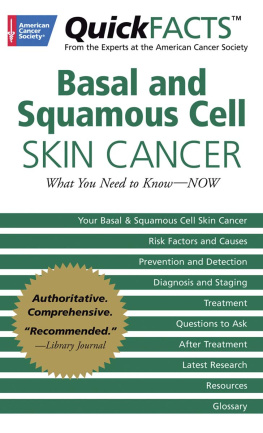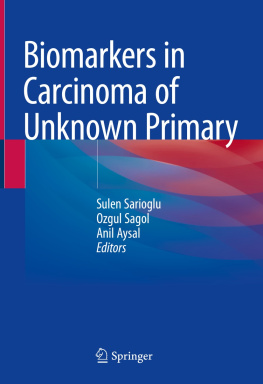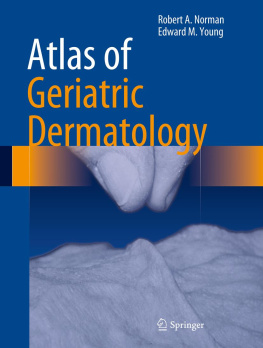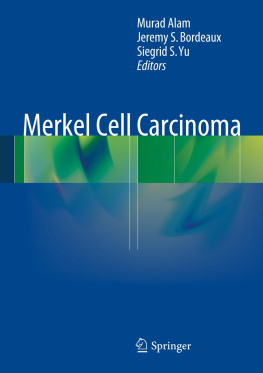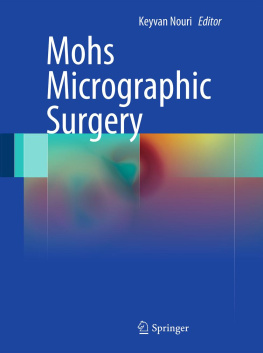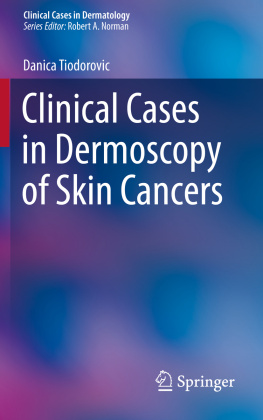Editors
Michael R. Migden , Leon Chen and Sirunya Silapunt
Basal Cell Carcinoma
Advances in Treatment and Research
Editors
Michael R. Migden
The University of Texas MD Anderson Cancer Center, Departments of Dermatology and Head and Neck Surgery, Mohs Surgery Center, Houston, TX, USA
Leon Chen
The University of Texas MD Anderson Cancer Center, Department of Dermatology, Houston, TX, USA
University of Texas McGovern Medical School at Houston, Department of Dermatology, Houston, TX, USA
Sirunya Silapunt
University of Texas McGovern Medical School at Houston, Department of Dermatology, Houston, TX, USA
ISBN 978-3-030-26886-2 e-ISBN 978-3-030-26887-9
https://doi.org/10.1007/978-3-030-26887-9
Springer Nature Switzerland AG 2020
This work is subject to copyright. All rights are reserved by the Publisher, whether the whole or part of the material is concerned, specifically the rights of translation, reprinting, reuse of illustrations, recitation, broadcasting, reproduction on microfilms or in any other physical way, and transmission or information storage and retrieval, electronic adaptation, computer software, or by similar or dissimilar methodology now known or hereafter developed.
The use of general descriptive names, registered names, trademarks, service marks, etc. in this publication does not imply, even in the absence of a specific statement, that such names are exempt from the relevant protective laws and regulations and therefore free for general use.
The publisher, the authors, and the editors are safe to assume that the advice and information in this book are believed to be true and accurate at the date of publication. Neither the publisher nor the authors or the editors give a warranty, expressed or implied, with respect to the material contained herein or for any errors or omissions that may have been made. The publisher remains neutral with regard to jurisdictional claims in published maps and institutional affiliations.
This Springer imprint is published by the registered company Springer Nature Switzerland AG
The registered company address is: Gewerbestrasse 11, 6330 Cham, Switzerland
To my father who inspired me by his dedication to medicine and always putting his patients interests first. To my wife for her love and support along the winding road.
Michael R. Migden, MD
To my parents, Ming-Meei (Rose) and Te-Hsiung (Ted), for their unconditional love and unwavering support. Thank you for always believing in me and inspiring me to dream big.
To my dearest wife, Patty, for her patience, understanding, and love. Thank you for being the rock of our family.
Lastly, to my sons, Levi and Luke, who were born during the writing of this book. You two have brought the greatest joy to our lives.
Leon Chen, MD
To my parents, Sopon and Jaree Silapunt, for their love, understanding, and never-ending support. To my husband for his love and daily inspiration.
Sirunya Silapunt, MD
Preface
We embarked on this journey to write about basal cell carcinoma not only because millions of individuals are affected by it every year but also there are many unanswered clinical questions faced by dermatologists and Mohs surgeons as well as other specialists. The treatment of this disease has largely been procedural: either with Mohs micrographic surgery, surgical excision, or destruction. Mohs micrographic surgery allows 100% of the tumor margin examined while sparing unnecessary tissue removal, and a step-by-step illustration of this surgical technique is detailed in this book. More recently, good options for patients with advanced basal cell carcinoma who are deemed poor surgical candidates have been developed. With the approval of vismodegib in 2012 and sonidegib in 2015 by the US Food and Drug Administration, patients with advanced basal cell carcinoma now have a viable alternative to disfiguring or morbid extensive surgery. Given the success of immunotherapy with program cell death 1 inhibitors in a wide variety of cancer types, multiple ongoing trials are investigating the efficacy and safety of immunotherapy for the treatment of advanced basal cell carcinoma.
We have assembled a multidisciplinary panel of specialists from diverse fields such as dermatology, dermatopathology, head and neck surgery, Mohs micrographic surgery, radiation oncology, and oculoplastic surgery to participate in the writing ofBasal Cell Carcinoma: Advances in Treatment and Research. This book provides an in-depth coverage of treatment for localized basal cell carcinomas including topical therapy, destruction, photodynamic therapy, local immunotherapy with interferon, and laser treatment. This book also includes an extensive review on combination therapies and comparative studies of various treatment modalities for basal cell carcinoma.
In cases of extensive, locally advanced basal cell carcinoma invading deeper structures, head and neck surgery offers highly effective deeper en bloc surgical extirpation for oncologic control. The role of radiation therapy as definitive or adjuvant therapy can be found in chapter Radiotherapy for Basal Cell Carcinoma. The chapter authors discuss different radiotherapy modalities such as orthovoltage irradiation, electron beam therapy and brachytherapy, as well as practical case studies of difficult-to-treat basal cell carcinomas.
Tumors located adjacent or within the orbit can present various challenges. These include higher risk for recurrence, higher complexity of reconstruction to preserve vision, and restoration of aesthetics. In chapter Special Consideration for Periocular Basal Cell Carcinoma, the authors share their clinical pearls in treatment of tumor and effective reconstruction of the orbital region.
Basal Cell Carcinoma: Advances in Treatment and Researchprovides the most comprehensive overview of evidence-based treatment approaches for basal cell carcinoma, the most common cancer worldwide. The first part of this book details epidemiology, risk factors, pathophysiology, and different histologic subtypes of basal cell carcinoma highlighted with high-resolution histopathology images. The second part of the book provides an in-depth review and practical pearls of different treatment modalities including topical therapy, local immunotherapy with interferon, cryotherapy, electrodesiccation and curettage, radiotherapy, and surgical approaches with Mohs micrographic surgery, head and neck surgery, and oculoplastic surgery. The final part of the book highlights the utilization of innovative technology such as photodynamic therapy and laser for the treatment of basal cell carcinoma as well as emerging systemic therapeutic options utilizing hedgehog pathway inhibitors and immunotherapy for the difficult-to-treat advanced disease states. It is our intention that this book will serve as an informative and evidence-based guide for physicians, mid-level providers, trainees, and healthcare personnel for years to come.
Michael R. Migden
Leon Chen
Sirunya Silapunt
Houston, TX, USA Houston, TX, USA Houston, TX, USA



